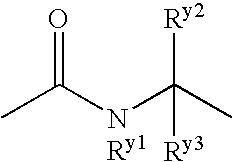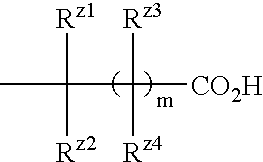Benzene compound and salt thereof
a technology of benzene compound and salt, which is applied in the field of new benzene compound, can solve the problems of social problems, morbid state of niddm, limited use of such medicines, etc., and achieve excellent anti-inflammatory effect and induce experimental colitis
- Summary
- Abstract
- Description
- Claims
- Application Information
AI Technical Summary
Benefits of technology
Problems solved by technology
Method used
Image
Examples
experiment example 2
Measurement of Transcriptional Activity
[0148]A GAL4-PPAR LBD chimera expression vector was constructed by ligating human PPAR 167–468 (PPAR), 138–440 (NUC-1) and 174–475 (PPAR) amino acid regions (LBD: Ligand Binding Domain) to a yeast transcriptional factor GAL4 1–147 amino acid region. As the reporter gene, PLAP (Placental Alkaline Phosphatase) was used, and this was ligated downstream of a TK promoter containing a 5-copy GAL4 DNA binding element to construct a vector. As host cells, CV-1 (ATCC CCL-70) was used. That is, CV-1 cells were spread at a density of 5×105 cells on a 35-mm dish and cultured in 10% FCS / DMEM for 24 hours, and using FuGENE 6 transfection reagent, the cells were co-transfected with the GAL4-PPAR LBD expression vector and GAL4 DBD-TK-PLAP expression vector. 24 hours after this transfection, the cells were spread again on a 96-well plate at a density of 1×104 / well and further cultured for 24 hours. After 24 hours, the medium was exchanged with DMEM containing 1...
example 1
Production Example 1a
[0153]
[0154]10.67 g of 5-bromo-2,3-dimethoxybenzaldehyde was dissolved in 100 ml of tetrahydrofuran and 100 ml of ethanol, and 1 g of sodium borohydride was added, and then the solution was stirred overnight at room temperature. 1 N hydrochloric acid was added thereto, followed by extracting with ethyl acetate. The organic layer was washed with water and an aqueous saturated sodium chloride, dried over anhydrous magnesium sulfate and the solvent was evaporated, to give 10.27 g of 5-bromo-2,3-dimethoxybenzyl alcohol. 5.326 g of this crude product was dissolved in 50 ml of N,N-dimethylformamide, and 1.8 g of imidazole and 5.9 g of t-butylchlorodiphenylsilane were added thereto, and the solution was stirred overnight at room temperature. The reaction mixture was diluted with ethyl acetate, and the organic layer was washed with water and saturated brine, dried over anhydrous magnesium sulfate and the solvent was evaporated, to give 10.72 g of [(5-bromo-2,3-dimethoxy...
production example 1b
[0156]
[0157]10.72 g of [(5-bromo-2,3-dimethoxybenzyl)oxy](t-butyl)diphenylsilane was dissolved in 100 ml of tetrahydrofuran, and the solution was cooled down to −78° C. in nitrogen atmosphere. To the solution, 16 ml of butyllithium (1.5 M hexane solution) was added, and the solution was stirred for 30 minutes, and 2.5 ml of 4-formylmorpholine was added thereto. After the solution was stirred for 1 hour at −78° C., 1 N hydrochloric acid was added, followed by extracting with ethyl acetate. The organic layer was washed with water and saturated sodium chloride, dried over anhydrous magnesium sulfate, and the solvent was evaporated. The residue was purified by silica gel column chromatography, to give 9.4 g of 3-([1-(t-butyl)-1,1-diphenylsilyl]oxymethyl)-4,5-dimethoxybenzaldehyde from fractions eluted with hexane-ethyl acetate (2:1 to 3:2).
[0158]1H-NMR (CDCl3) δ: 1.12 (s, 9H) 3.77 (s, 3H) 3.91 (s, 3H) 4.84 (s, 2H) 7.39–7.44 (m, 7H) 7.69–7.72 (m, 5H) 9.91 (s, 1H)
PUM
| Property | Measurement | Unit |
|---|---|---|
| temperature | aaaaa | aaaaa |
| temperature | aaaaa | aaaaa |
| temperature | aaaaa | aaaaa |
Abstract
Description
Claims
Application Information
 Login to View More
Login to View More - R&D
- Intellectual Property
- Life Sciences
- Materials
- Tech Scout
- Unparalleled Data Quality
- Higher Quality Content
- 60% Fewer Hallucinations
Browse by: Latest US Patents, China's latest patents, Technical Efficacy Thesaurus, Application Domain, Technology Topic, Popular Technical Reports.
© 2025 PatSnap. All rights reserved.Legal|Privacy policy|Modern Slavery Act Transparency Statement|Sitemap|About US| Contact US: help@patsnap.com



